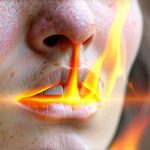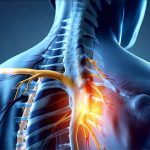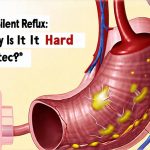Gastroesophageal reflux disease (GERD) is a surprisingly common condition, affecting millions worldwide. It’s often associated with classic symptoms like heartburn and acid indigestion, but its reach extends far beyond these familiar complaints. Many individuals experience atypical GERD symptoms, which can be confusing and difficult to diagnose. One such symptom gaining increasing attention is persistent phlegm production, even in the absence of a cold or flu. This seemingly unrelated issue can actually be a significant indicator of underlying reflux, often leading people on frustrating diagnostic journeys before connecting the dots. Understanding this connection is crucial for effective management and relief. If you’re struggling to get answers, consider reading about being taken seriously with normal bloodwork.
The link between GERD and excessive mucus isn’t always straightforward. While we typically associate phlegm with respiratory infections, chronic acid exposure from reflux can irritate the esophagus and throat, triggering the body’s natural defense mechanisms – namely, increased mucus production. This isn’t a response to a viral or bacterial threat; it’s an attempt by the body to neutralize and protect itself from the damaging effects of stomach acid. The resulting phlegm can feel thick, sticky, and persistent, often requiring frequent clearing of the throat. It’s important to note that this isn’t necessarily about large volumes of mucus, but rather a constant presence which feels disruptive and uncomfortable. This phenomenon highlights the diverse ways GERD can manifest, making diagnosis more challenging than simply looking for heartburn. Dealing with these challenges can be stressful; it might be helpful to explore how to deal with food fear.
The Reflux-Phlegm Connection Explained
The digestive system is designed to keep stomach acid contained within its boundaries. However, in individuals with GERD, this barrier weakens or fails intermittently. Several factors contribute to this, including a weakened lower esophageal sphincter (LES) – the muscle that acts as a valve between the esophagus and stomach – hiatal hernia, delayed gastric emptying, or even lifestyle choices like diet and body position. When acid refluxes into the esophagus, it can directly irritate the delicate lining, causing inflammation and discomfort. But the irritation doesn’t stop there; this acidic backwash often reaches higher up, affecting the throat and even the sinuses.
This upward migration of acid is what triggers increased mucus production. The body perceives the acid as an irritant and attempts to coat and neutralize it with phlegm. Unlike phlegm produced during a cold, which tends to be thinner and clearer, reflux-induced phlegm can be thicker and may have a slightly bitter or sour taste due to residual acid contact. It’s also often worse after meals, when lying down, or at night – all situations that exacerbate reflux. The constant need to clear the throat, coupled with a feeling of something stuck in the back of the throat (globus sensation), are common complaints associated with this type of phlegm production.
The impact isn’t just physical. Chronic irritation and the constant clearing of the throat can contribute to vocal fatigue, hoarseness, and even a persistent cough. Many people initially attribute these symptoms to allergies or postnasal drip, leading to misdiagnosis and ineffective treatments. It’s vital to consider GERD as a potential underlying cause when experiencing unexplained, chronic phlegm production, especially if other reflux symptoms are present, even mild ones. In cases where you suspect this might be the issue, understanding GERD with esophagitis can provide valuable context.
Identifying the Source: Differentiating Reflux Phlegm from Other Causes
Pinpointing the source of persistent phlegm can be tricky, as several conditions share similar symptoms. Allergic rhinitis (hay fever), postnasal drip due to sinusitis, and chronic bronchitis all involve mucus production and throat clearing. The key difference lies in understanding the trigger and associated symptoms. Allergies typically present with itchy eyes, sneezing, and a runny nose. Sinusitis often involves facial pain or pressure and nasal congestion. Bronchitis usually comes with a cough that produces colored sputum (yellow or green).
Reflux-related phlegm, however, tends to be more persistent and less associated with typical respiratory symptoms. It’s frequently described as being thicker, stickier, and sometimes having an unpleasant taste. A key diagnostic clue is the timing of the phlegm production. Does it worsen after meals? When lying down? At night? These patterns strongly suggest a reflux origin. Furthermore, individuals with GERD-related phlegm may experience other subtle signs of reflux, such as:
- Heartburn (though not always present)
- Acid indigestion
- Regurgitation (a sour taste in the mouth)
- Difficulty swallowing (dysphagia)
- Chronic cough
- Hoarseness
A thorough medical evaluation is crucial to differentiate between these conditions. Doctors may use a variety of diagnostic tools, including endoscopy, esophageal manometry, and pH monitoring, to confirm GERD as the underlying cause. It’s important not to self-diagnose; seeking professional guidance ensures accurate identification and appropriate treatment. Feeling confident when navigating healthcare can be challenging, but dining out with confidence is possible.
Diagnostic Tools for Uncovering Reflux
Determining if GERD is the root cause of persistent phlegm requires more than just symptom analysis. Several diagnostic tools can help healthcare professionals pinpoint the issue with greater accuracy. One common method is endoscopy, where a thin, flexible tube with a camera attached is inserted down the esophagus to visualize the lining and check for inflammation or damage caused by acid reflux. Biopsies can be taken during endoscopy to further assess any abnormalities.
Another important test is esophageal manometry. This procedure measures the pressure within the esophagus and assesses the function of the LES. It helps determine if the LES is weak or dysfunctional, allowing stomach acid to flow back up into the esophagus. Finally, ambulatory reflux monitoring, often utilizing a small capsule temporarily attached to the esophageal wall, can measure the amount of acid exposure over a 24-hour period. This provides valuable data on the frequency and severity of reflux episodes, even those that don’t cause noticeable symptoms. The choice of diagnostic tools will depend on the individual’s specific symptoms and medical history.
Lifestyle Modifications for Managing Reflux & Phlegm
Once GERD is identified as a contributing factor to persistent phlegm, managing the condition often involves a combination of lifestyle modifications and, in some cases, medication. Lifestyle changes are frequently the first line of defense. These include:
- Dietary adjustments: Avoiding trigger foods like caffeine, chocolate, alcohol, spicy foods, fatty foods, and citrus fruits can significantly reduce reflux episodes.
- Portion control: Eating smaller, more frequent meals instead of large ones helps minimize stomach pressure.
- Elevating the head of your bed: Raising the head of your bed by 6-8 inches using blocks or a wedge pillow can help prevent acid from flowing back up into the esophagus while you sleep.
- Avoiding eating close to bedtime: Allow at least 2-3 hours between your last meal and going to bed.
- Weight management: Losing excess weight can reduce pressure on the stomach, lessening the likelihood of reflux.
These modifications are often sufficient for mild cases of GERD. However, more severe symptoms may require medical intervention. Remember that open communication with family can be incredibly helpful during times of health challenges.
Medical Interventions & Future Considerations
For individuals who don’t respond to lifestyle changes, several medical interventions are available. Medications like proton pump inhibitors (PPIs) and H2 receptor antagonists can reduce stomach acid production, alleviating reflux symptoms. However, long-term use of PPIs has been associated with potential side effects, so their use should be carefully monitored by a healthcare professional. In rare cases where medication and lifestyle changes are insufficient, surgery to strengthen the LES may be considered.
Looking ahead, research continues to explore new approaches to GERD management. Innovative therapies aimed at strengthening the LES or improving gastric emptying are under development. Furthermore, understanding the interplay between gut microbiome and reflux is gaining traction as a potential avenue for novel treatments. Ultimately, effective management of GERD-related phlegm requires a collaborative approach between patients and healthcare professionals, focusing on accurate diagnosis, personalized treatment plans, and ongoing monitoring. Addressing this often overlooked symptom can significantly improve quality of life for those affected by this complex condition. If you’re experiencing symptoms that are impacting your daily life, remember coping with fatigue is possible and seeking help is a sign of strength. Also, consider tips for avoiding liver stress to support overall well-being.


















